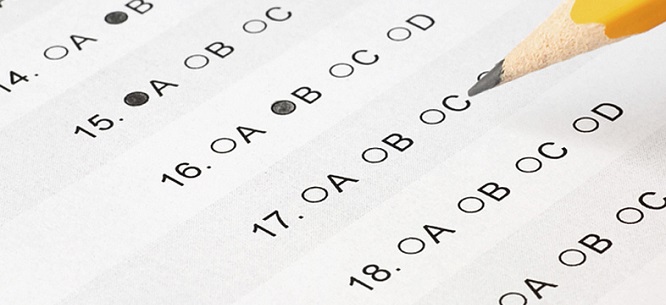Grading the Test: The New SAT Reforms
Grading the Test: The New SAT Reforms
Last week, the College Board announced changes to the Scholastic Aptitude Test because it had “become disconnected from the work of our high schools.” But can test reforms change the class and racial biases of U.S. college admissions?

Last week, the College Board announced changes to the Scholastic Aptitude Test because it had “become disconnected from the work of our high schools.” But can test reforms diminish the class and racial biases of U.S. college admissions? Here are some essays from our archives on the SAT.
“The Meritocracy Trap,” by Kim Phillips-Fein (Spring 2000)
In respectable American opinion, perhaps the Constitution is the only institution treated with more obligatory reverence than the elite university. . . . Perhaps it’s not surprising that entrance into this privileged world should be contingent on a test thought to measure the elusive, intangible quality of “aptitude,” not ability, an exam invested with the mystic power to cut through the vagaries of birth, place, status, and parentage to measure innate capacity for learning. . . .
Denouncing the “culture of frenzy surrounding admissions” as “destructive and anti-democratic,” [Nicholas Lemann] calls for replacing the SAT with tests demonstrating mastery of the high school curriculum, while permitting “the richest rewards of money and status” to “devolve to people only temporarily, and strictly on the basis of their performance; there would be as little lifelong tenure on the basis of youthful promise as possible.” But most of all, he believes in expanding and improving schools for all: “The best and most distinctive tradition in American education is the tradition of pushing to educate more people.”
All of this is dewy-eyed Deweyism, a refreshing counter to conservatives who suggest that black and Hispanic kids who need remedial classes shouldn’t be in college at all. But expanded education and fairer tests won’t in and of themselves create a more egalitarian or democratic society. Though he’s in favor of the GI bill while they believed in the SAT, Lemann shares the postwar liberals’ vision of universities as cities on a hill, which can be a light unto the nation. This ultimately limits his vision as much as it did theirs. The gap in American society he bemoans is not, fundamentally, one that has much to do with education (let alone intelligence or merit), and so it isn’t one that can easily be redressed through the school system or through a better system of testing. Taxes on inheritance and wealth, fairer labor laws, and a higher minimum wage will do far more to create the democratic society he hopes for than any number of new classrooms or any new big test.
“Buying Your Way to the Top: A Cadillac Education,” by Keith Spencer (February 8, 2013)
At the high-end New York tutoring company where I work, I am trained in the art of interacting with the bourgeoisie: in one exercise, the new tutors and I receive a lesson in how to talk to the “Wall Street Dad” archetype. “I want you to understand that my child has to get into Princeton or Yale, maybe Stanford,” the actor barks at me. Wall Street Dad asks where I went to college and what I studied. “Physics at Oberlin?” he scoffs. “Bad school, though I guess your major’s not totally worthless. But I want my son to study physics at a real school like Princeton.” Later, our trainers will swear that all the interactions are based directly on interactions with real parents. . . .
If the 1 percent and their private school tuitions were taxed properly, making my job obsolete and stemming the glut of money going to the tutoring arms race, this tax money would provide for more teachers, counselors, books, and schools for the public. I am sure that many of my co-workers would rather work in this kind of society, as equal-opportunity educators, than as tutors for a privileged few.
“The College as Rat-Race: Admissions and Anxieties,” by Robert Paul Wolff (Winter 1964)
[A]s so many perceptive observers of adolescents have pointed out, growth from childhood to maturity is necessarily ungainly. It is the trying on of ideals and life styles, the committing of new-found emotional energies. As Erik Erikson has shown us through his study of Luther, the “identity crisis” of late adolescence or early adulthood is positively creative, and certainly not an embarrassing misfortune to be excused and quickly suppressed.
Unfortunately, the college race has just this repressive effect on many of the most intelligent and sensitive—hence vulnerable—youngsters. Experiment and commitment require a willingness to accept the possibility of failure. They demand an incautious, even imprudent singleness of purpose. The wise counseling and anxious hectoring of the college-mongers is death to experiment. . . .
The harm [college admissions] inflict on high school students does not flow from their imperfections. It flows from their very existence. So long as the education in our colleges varies widely in quality, and admission to college is based on an evaluation of pre-college performance, parents and teachers will push students into a competition for admission.




